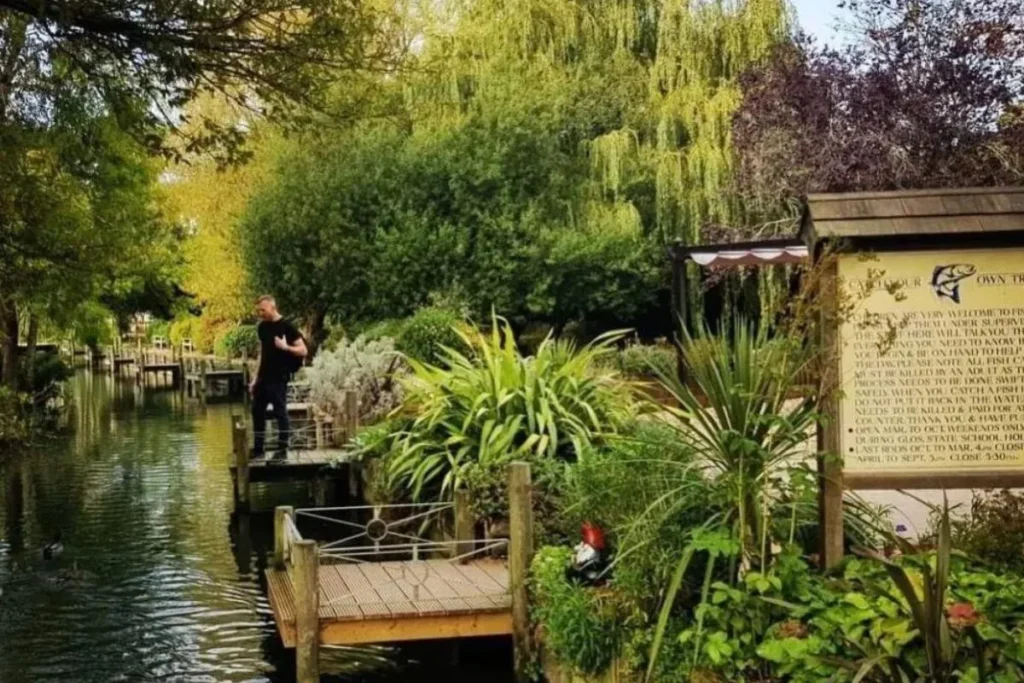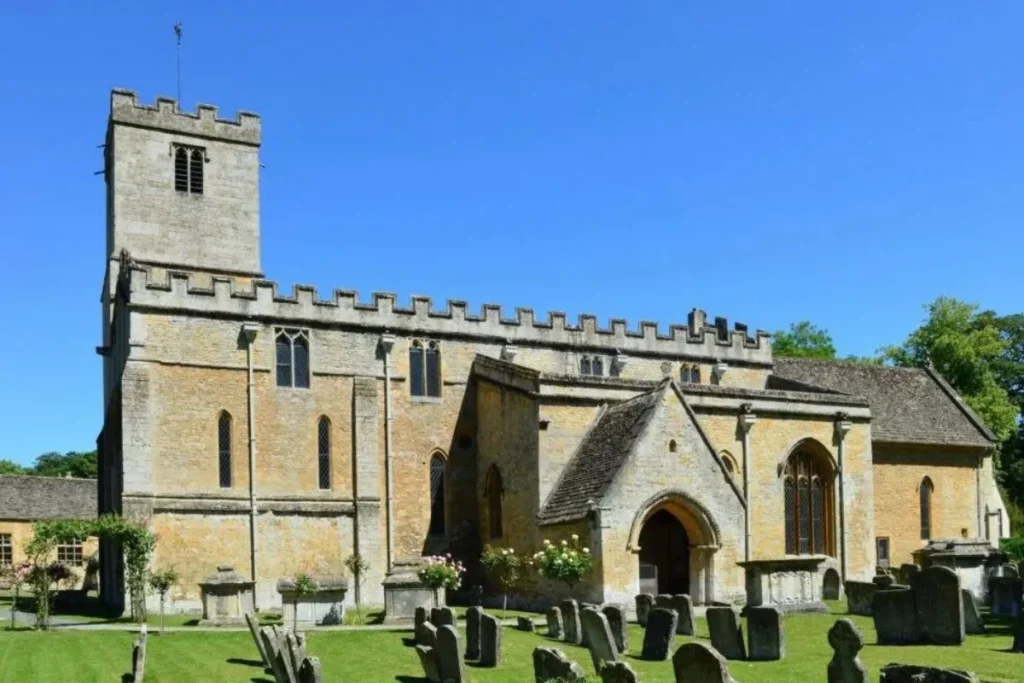Bibury- The Most Beautiful Village in England
Bibury is a charming, typically Cotswold, village just a short drive from Cotswolds, Cirencester. It’s a place where time seems to have stood still, preserving the quintessential beauty and tranquility of the English countryside. This village has earned its reputation as one of the most beautiful place in UK. 19th century designer and writer William Morris once described it as the “most beautiful village in England”.
For centuries, Bibury’s unspoiled beauty has captivated visitors seeking the quintessential charm of the English countryside.

Bibury’s Cotswolds History
Bibury’s rich history is woven into the very fabric of the village, a tapestry of centuries old tradition along with historical buildings and archaeological finds.
The Domesday Book of 1086, an extensive survey commissioned by William the Conqueror, recorded Bibury as “Becheberie. At that time, the lands and church in Bibury were held by St. Mary’s Priory in Worcester. In 1130, these holdings transferred to the Abbey of Osney near Oxford, which maintained control until the Abbey’s dissolution in 1540 during the English Reformation.
A local historian, George Witts, made one of the most intriguing historical finds in this village when he accidentally discovered a Roman villa in 1880. Located about six miles northeast of Cirencester, Witts uncovered the villa during routine activities in the parish.
The excavation revealed Roman pottery, some coins, and remnants of tesselated pavements, even though the site was never fully investigated. This discovery further enriches the village’s historical narrative, highlighting the intriguingly rich history of the area that extends back to Roman times.

Best Places to Visit in Bibury
There are so many great sights in Bibury Cotswolds, and it is pretty hard knowing where one should begin. Here are some of the best things to do in Bibury to get you started.
Arlington Row

Arlington Row forms one of the most spectacular rows of historic cottages located in the Cotswolds. It was built in 1380 as a wool store but was converted during the 17th century into weavers cottages.

Known for its ageless beauty, Arlington Row features honey colored stone cottages with steeply pitched roofs lining a quiet road beside the River Coln. Often cited as one of the most photographed sites in the UK, as this iconic location attracts countless visitors. While most cottages are privately owned, one is available as a holiday rental, offering visitors a unique stay in this quintessential English village.
Arlington Row isn’t only popular for its remarkable beauty, it has also made its mark in the cinema world. Filmmakers used this magical place as a location in the 2007 fantasy film Stardust. The film, with its magical storyline and stunning visuals, perfectly showcased the timeless charm of Arlington Row.
Trout Farm

Established in 1902, Trout Farm is one of England’s oldest working trout farms, set in the heart of the Cotswold village of Bibury. Covering over 15 acres, the farm specializes in breeding high quality Rainbow and Brown Trout.
Visitors can explore the tranquil grounds, feed the fish, and even catch their own trout in designated areas. The farm also contains a shop selling locally produced fresh and smoked trout, along with a café for refreshments. This spot is very popular with families, nature lovers, and anyone wanting a slice of rural English life.
Awkward Hill
Awkward Hill in Bibury is a pretty and picturesque place that presents visitors with the most striking view of the Cotswold countryside. This gently sloping hill lies just above the famous Arlington Row, serving as a beautiful backdrop to the village. A stroll on top of Awkward Hill offers a serene view of the surroundings, with greenery, ancient stone walls, and rich flora and fauna.
Church of St. Mary

The Church of St Mary of Bibury is a historic and serene Anglican church that dates back to the Saxon period, with significant Norman features added in the 12th century. From 1130 until the 16th-century English Reformation, this ancient church served as a peculiar of Osney Abbey. It stands as a testament to the village’s long standing religious heritage.
One of the church’s most striking feature is the stained-glass window in the north chancel wall, designed by Karl Parsons in 1927. This window was notably featured in the 1992 Christmas stamp set issued by the Royal Mail, further cementing its place in the village’s cultural history.
Meanwhile the churchyard is very peaceful, with ancient gravestones surrounded by trees. Inside the church, visitors find a calm, reflective atmosphere, making it a must see for those interested in history, architecture, and spiritual enlightenment.
Rack Isle
Rack Isle is a small and enchanting area situated between the famous cottages of Arlington Row and the River Coln. In the past, locals used this area for drying wool on racks, reflecting Bibury’s history in the wool trade.
Nowadays, Rack Isle is a protected nature preserve known for its rich biodiversity. This marshy land is home to a variety of animals, such as ducks, water voles, and many species of birds, making it a great spot for every nature lover and photographer.
Heavy vegetation of wildflowers and reeds adds to the tranquility of this area. Walking through Rack Isle offers a peaceful retreat with stunning views of the river and the surrounding Cotswold countryside. Above all it’s a wonderful place to connect with nature while visiting Bibury.
Arlington Mill

Bibury’s Arlington Mill is an old historic watermill from the 17th century. It was used as a corn mill but later became a cloth mill, reflecting the village’s connection to the wool trade.
In addition, with its charming stone structure and attractive location by the River Coln, the mill has been well maintained over the years and now serves as a private residence. Even though it is closed to the public, its exterior adds rustic beauty to Bibury. It also gives a glance into the industrial history and its role in the Cotswold’s rich heritage.
How to get to the Bibury?
By car
Bibury is located on B4425 between Aldsworth and Barnsley, Cotswolds. It is about 80 miles west of London, and the drive takes around two hours. If you’re coming from Oxford, it’s just a 40 minute drive.
By Public Transport
If you prefer public transport, the nearest train station to Bibury is in Kemble, about 14 miles away. From Kemble, you can either take a taxi or catch a local bus to reach there. In addition, you can take a train to Swindon and then hop on a bus to Cirencester. From Cirencester, a connecting bus will take you directly to the village.
Parking
There is a small parking area conveniently located near the River Coln. But, spaces can be limited, especially during peak tourist season when the village is at its busiest. To ensure you get a spot, it’s a good idea to arrive early in the day.
Why Bibury Should Be on Your Bucket List?
Bibury isn’t just seen as another beautiful village, it’s nothing short of a picture-perfect scene filled with all the charm of the English countryside. With its honey-colored stone cottages, especially the iconic Arlington Row, it presents a setting that has remained unchanged for centuries. Visiting Bibury feels like stepping into a real life wonderland.

The village is steeped in history at every corner, from its origins in the wool trade to historic buildings such as The Church of St. Mary and Arlington Mill. As you walk along the River Coln, greenery and serene landscapes are encountered, further adding to its enchanting appeal. Walking by The Rack Isle or simply relaxing by the river, Bibury will give you an experience that’s both magical and memorable.

Whether you’re a history enthusiast, a nature lover, or just looking to escape the hustle and bustle of modern life, this enchanting Cotswold village is the perfect destination. So, pack your bags, set your GPS, and get ready to explore one of England’s most beautiful villages-you won’t be disappointed!




Absolutely gorgeous!
Prompt, where I can read about it?
Reading this felt like having a conversation with someone who knows exactly how to make you see things in a new light.
This brings a smile.
Just what I needed today.